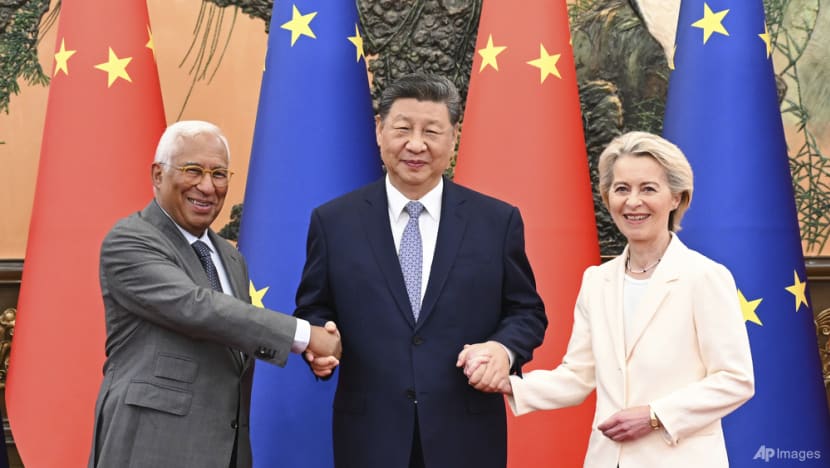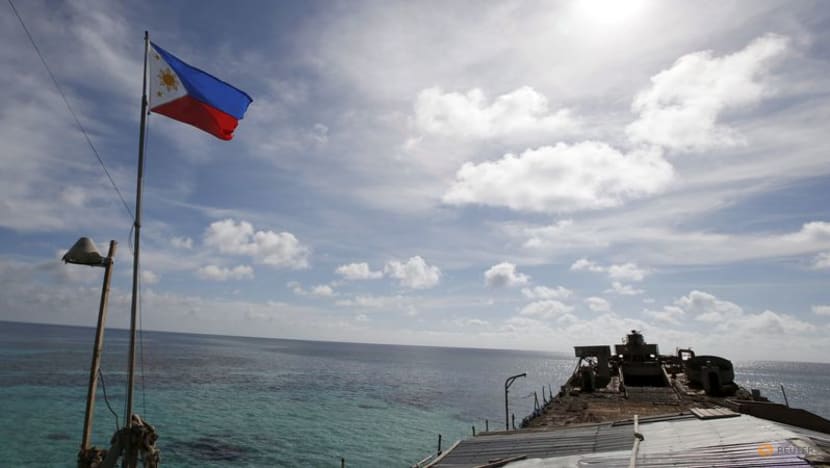Commentary: EU-China ties will shape strategic room for Southeast Asia
The EU-China summit in Beijing laid bare the underlying frictions in that relationship, which present both challenges and opportunities for Southeast Asia, says Daniel Balazs of the S Rajaratnam School of International Studies. Â

Chinese President Xi Jinping, centre, with visiting President of the European Council Antonio Costa, left, and President of the European Commission Ursula von der Leyen, right, ahead of the China EU Summit, at the Great Hall of the People in Beijing on Jul 24, 2025. (Photo: Xie Huanchi/Xinhua via AP)

This audio is generated by an AI tool.
SINGAPORE: European leaders met Chinese President Xi Jinping and Premier Li Qiang in Beijing on Thursday (Jul 24) at the EU-China summit, marking 50 years of diplomatic ties.
In the era of Trump 2.0, China and the EU could have been a perfect match – at least in theory.
They have a significant economic relationship and a mutual commitment to the multilateral trading system. According to 2024 data, they are each other’s second-biggest trading partners, with bilateral trade exceeding US$760 billion.
In April, Beijing and Brussels agreed that United States President Donald Trump’s tariffs hurt international commerce, and committed to resolving their differences to “jointly safeguard the normal functioning of global trade”.
While these circumstances create a conducive setting for alignment, underlying frictions in security and trade had impeded summit preparations and strained their ties.
In June, Brussels refused to hold a flagship economic meeting that usually serves a key role in summit preparations. Furthermore, China shortened the summit from two days to one, removing the Friday business meeting from the agenda. Against this backdrop, expectations of the summit were already low.
The atmosphere at the meetings was reportedly tense. Mr Xi argued that the EU and China are at a “critical juncture in history” and had to “make the right strategic choices” to advance international stability. EU Commission President Ursula von der Leyen noted that relations have reached an “inflection point” and need “real solutions” to advance.
How both sides manage these issues and the trajectory of their relationship after the summit present both challenges and opportunities for Southeast Asia.
TENSIONS OVER UKRAINE AND SOUTH CHINA SEA
In the realm of security, one key challenge of EU-China ties is their divergent perspective on the conflict in Ukraine.
While China officially denies that it aids Russia’s military‑industrial base, the EU considers China a “key enabler” of Moscow’s war effort in Ukraine. Multiple rounds of EU sanctions on Russia have included Chinese entities for their purported support to the Russian war machine.
The latest package blacklisted Chinese banks for the first time, with two regional banks allegedly helping Russia to bypass economic sanctions.
At the summit, European Council President Antonio Costa called on China to leverage its influence on Russia to help end the war.
At the same time, some of the EU’s activities in Asia trigger security concerns in China.
In June, EU High Representative for Foreign Affairs and Security Policy Kaja Kallas visited the Philippines – a South China Sea disputant – and Brussels agreed to establish a dialogue on security and defence with Manila. During the visit, Ms Kallas reiterated the EU’s commitment to “addressing common concerns in the South China Sea”.
Subsequently, the Chinese embassy to the Philippines told the European Union to refrain from stirring trouble in the South China Sea, and advised Manila against dragging external forces into the dispute.

DISAGREEMENTS OVER TRADE
On the trade front, one of the EU’s chief concerns is the Chinese government’s subsidies that lead to the inflow of cheap products into Europe. This has led the EU to put defensive trade measures in place that subsequently triggered retaliation from Beijing, in a counterproductive spiral.
Last October, the EU imposed definitive anti-subsidy duties on battery electric vehicles imported to the bloc from China. In addition, the EU imposed provisional anti-dumping duties on hardwood plywood imports from China, and is currently conducting an anti‑dumping investigation into tire imports.
Beijing also imposed trade measures on Brussels. It unleashed anti-dumping duties on brandy imported to China from the EU, while exempting some of the biggest producers. Moreover, China has an ongoing anti-subsidy probe into dairy products and an anti‑dumping investigation into pork imports from the EU. At the summit, Brussels called on Beijing to end these measures, which remain a sticking point in their relationship.
Apart from long-standing concerns about product dumping, the EU is also worried about China’s restrictions on rare earth exports, given its high dependence on those materials. Beijing’s export controls since April have delayed rare earth supplies to Europe and disrupted industrial production across the continent.
Even though Beijing fast-tracked related administrative processes, the EU emphasised the negative impact of restrictions at the summit and is pushing for a closure of export controls altogether – something that China seems unwilling to do.
The summit confirmed that what Beijing regards as interdependence and interconnectivity is a source of geoeconomic vulnerability in the eyes of Brussels.
EU-CHINA TIES HAVE SIGNIFICANCE FOR SOUTHEAST ASIA
This top-level EU-China meeting and the subsequent development of their relationship carry significant implications for Southeast Asian nations, which were among the hardest hit by Mr Trump’s initial tariff salvo until recent deals.
A protracted stalemate could lead China to view the EU’s increasing courtship of Southeast Asia with heightened suspicion, making it more difficult for the region to deepen ties with Europe without straining relations with Beijing. Further restrictions on European imports from China could exacerbate the already significant flow of cheap Chinese goods to the region.
In addition, the EU could increase scrutiny on its imports from Southeast Asia, as Chinese businesses could reroute their Europe-bound imports to traverse through the region to dodge tariffs.
If Beijing and Brussels manage to reduce key trade tensions at a later point, pressure would ease on the global trading system, already under strain from Washington’s unilateral and protectionist policies.
As US tariffs push Southeast Asian nations to scale back links with China, strengthening trade relations with the EU – ASEAN’s third-largest trading partner – could provide an alternative source of growth and stability.
Ultimately, the trajectory of EU-China relations after the summit will not only shape their economic and security ties but also influence Southeast Asia’s strategic room for manoeuvre in a rapidly shifting global landscape.
Daniel Balazs is a Research Fellow in the China Programme of the S Rajaratnam School of International Studies, Nanyang Technological University, Singapore. The views expressed are his own and do not represent the views of his affiliated institutions.














